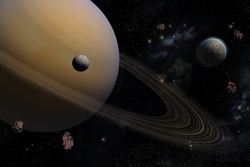Ephemerides updated with old observations
Ephemerides is the scientific term used for the mathematical calculation employed to determine the position and orbit of natural satellites. Space scientists use ephemerides to locate where satellites or their host planets will be at specific points in the future. They need this information to plan manoeuvres known as 'fly-bys' during which spacecraft pass close to the target to collect observations. Analysis of the satellites' dynamics, combined with high-precision observations, allows scientists to probe host planets' interiors by modelling gravitational fields. To date, studies of planetary geodesy and dynamics are fragmented, being conducted by the European Space Agency (ESA) as well as several national research institutions and universities. An EU-funded initiative sought to bring together the expertise available in Europe. Within the project ESPACE(opens in new window) (European satellite partnership for computing ephemerides), seven universities and research centres joined their efforts to find new ways to calculate ephemerides. At the heart of their efforts were observations collected from space missions to cover gravity, each celestial object's orientation and tidal effects – some of them had never been used before. Space-borne observations were combined with data from ground-based observatories, including photographic plates from long-focus instruments to improve constraints on the motion of solar system satellites. Some observatories, particularly in the United States, keep a large number of photographic plates that have never been analysed using modern computing techniques. Plates from the United States Naval Observatory (USNO) and other institutes were digitised with a new-generation scanning machine. Going back in time provided the time span needed to identify tiny deviations in satellites' motion. It was by using this piece of information that ESPACE researchers could calculate more accurately the location of moons of Mars, Saturn and Uranus. All the data scanned and analysed have been made available through the ESPACE Natural Satellites DataBase(opens in new window) and are ready to use for ephemerides calculations. Digitised astrometric data together with satellite data have already been used to improve orbit models of spacecraft. The results will be valuable for prospective planetary missions such as ExoMars. More importantly, ESPACE has created Europe's first network of space scientists working on ephemerides. The impact of the project is expected to be visible in the next years. The partners are already planning to continue working together and see how their separate data sets could be better used.




